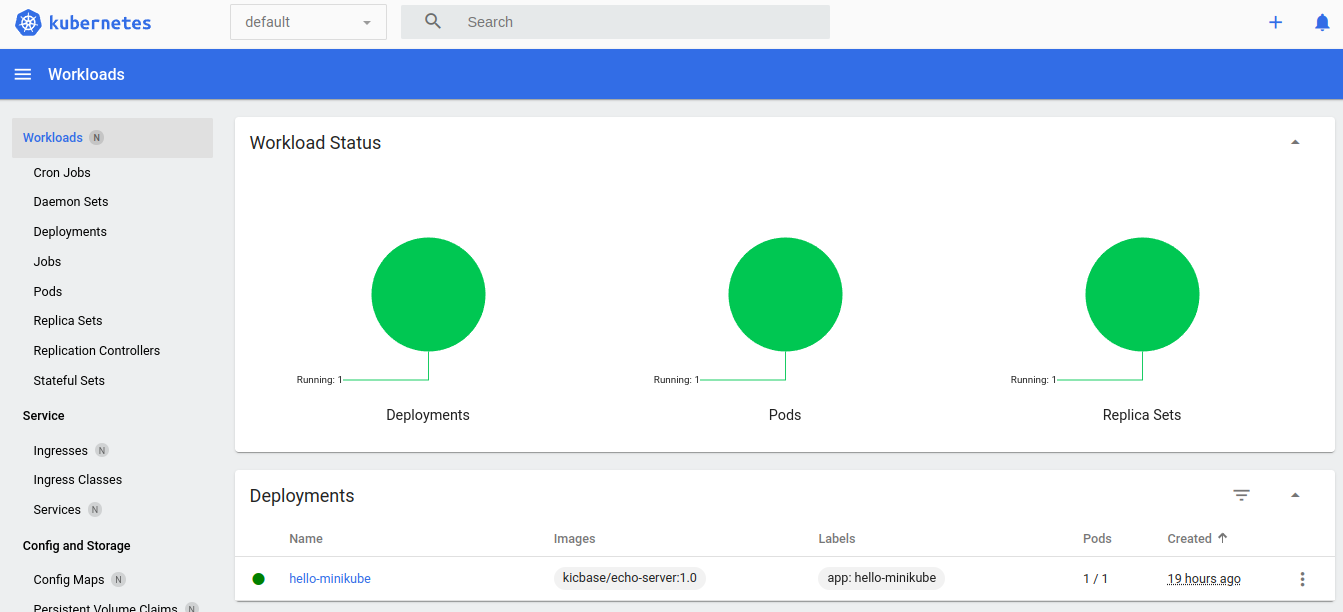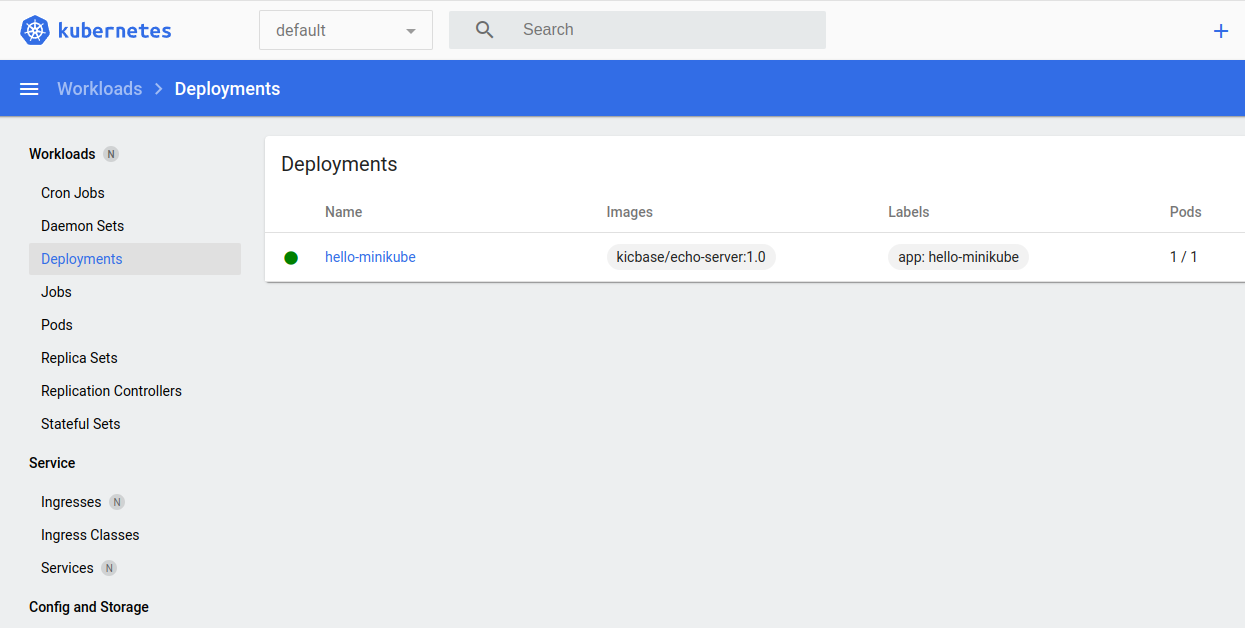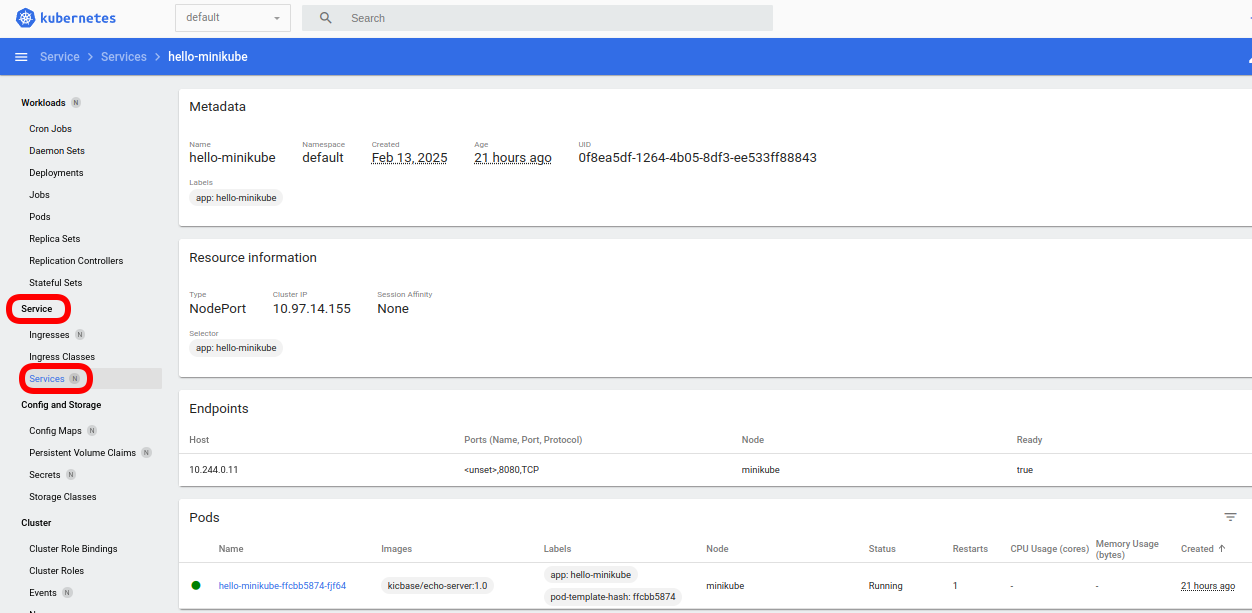1. Запуск minikube
vasi@v:~/tools$ minikube start --driver=podman & 😄 minikube v1.35.0 on Linuxmint 22 ✨ Using the podman driver based on existing profile 👍 Starting "minikube" primary control-plane node in "minikube" cluster 🚜 Pulling base image v0.0.46 ... E0213 19:55:57.018957 292421 cache.go:222] Error downloading kic artifacts: not yet implemented, see issue #8426 🔄 Restarting existing podman container for "minikube" ... ❗️ Failing to connect to https://registry.k8s.io/ from inside the minikube container 💡 To pull new external images, you may need to configure a proxy: https://minikube.sigs.k8s.io/docs/reference/networking/proxy/ 🐳 Preparing Kubernetes v1.32.0 on Docker 27.4.1 ... 🔎 Verifying Kubernetes components... ▪️ Using image gcr.io/k8s-minikube/storage-provisioner:v5 ▪️ Using image docker.io/kubernetesui/dashboard:v2.7.0 ▪️ Using image docker.io/kubernetesui/metrics-scraper:v1.0.8 💡 Some dashboard features require the metrics-server addon. To enable all features please run: minikube addons enable metrics-server 🌟 Enabled addons: dashboard, default-storageclass, storage-provisioner 🏄 Done! kubectl is now configured to use "minikube" cluster and "default" namespace by default
2. Запуск dashboard
vasi@v:~/tools$ minikube dashboard & 🤔 Verifying dashboard health ... 🚀 Launching proxy ... 🤔 Verifying proxy health ... 🎉 Opening http://127.0.0.1:37435/api/v1/namespaces/kubernetes-dashboard/services/http:kubernetes-dashboard:/proxy/ in your default browser... Opening in existing browser session.
(подождать 2-3 мин.)
3. Запуск proxy для доступа к minikube из сети
vasi@v:~/tools$ kubectl proxy --address='0.0.0.0' --disable-filter=true & [2] 651193 W0214 15:09:01.808784 651193 proxy.go:177] Request filter disabled, your proxy is vulnerable to XSRF attacks, please be cautious Starting to serve on [::]:8001
Порт 8001. Можно открыть из сети (192.168.1.20 - ip адрес компьютера с minikube). После этого можно открыть dashboard с удаленного компьютера: http://192.168.1.20:8001/api/v1/namespaces/kubernetes-dashboard/services/http:kubernetes-dashboard:/proxy/#/workloads?namespace=default

4. Проверка работы.
Вместе с minikube (для тестов, обучения) ПОСТАВЛЯЕТСЯ приложение hello_minikube.
Описание hello_minikube:
Deployments:

Services:

Внутренний порт (порт приложения) 8080 перенаправляется на внешний порт (снаружи kubernetes) 30449.
Детали сервиса. Путь в меню: Service - Services - "hello-minikube":

Проверка работы сервиса:
https://minikube.sigs.k8s.io/docs/handbook/accessing/
https://github.com/hartzler/hello-minikube
Получить порты приложений Kubernetes:
vasi@v:$ kubectl get svc NAME TYPE CLUSTER-IP EXTERNAL-IP PORT(S) AGE hello-minikube NodePort 10.97.14.155 none 8080:30449/TCP 21h kubernetes ClusterIP 10.96.0.1 none 443/TCP 22h
Или так (отобразится еще и адрес):
vasi@v:$ minikube service hello-minikube --url http://192.168.67.2:30449
Порт приложения 8080 hello-minikube перенаправлен на внешний порт 30449.
Проверка снаружи minikube:
$ http http://192.168.67.2:30449/ HTTP/1.1 200 OK Content-Length: 186 Content-Type: text/plain Request served by hello-minikube-ffcbb5874-fjf64 HTTP/1.1 GET / Host: 192.168.67.2:30449 Accept: */* Accept-Encoding: gzip, deflate, br Connection: keep-alive User-Agent: HTTPie/3.2.2
5. Остановка сервиса
$ minikube stop ✋ Stopping node "minikube" ... 🛑 Powering off "minikube" via SSH ... ✋ Stopping node "minikube" ... 🛑 Powering off "minikube" via SSH ... ✋ Stopping node "minikube" ... 🛑 1 node stopped.
6. Работа с Kubernetes
Получение log:
$ kubectl logs hello-minikube-ffcbb5874-fjf64 Echo server listening on port 8080.
hello-minikube-ffcbb5874-fjf64 - id pod. Узнать тут:
$ kubectl get pod NAME READY STATUS RESTARTS AGE hello-minikube-ffcbb5874-fjf64 1/1 Running 4 (109m ago) 39h
или

А вообще, есть неплохая помощь:
$ kubectl get -h
Display one or many resources.
Prints a table of the most important information about the specified resources. You can filter the list using a label
selector and the --selector flag. If the desired resource type is namespaced you will only see results in the current
namespace if you don't specify any namespace.
By specifying the output as 'template' and providing a Go template as the value of the --template flag, you can filter
the attributes of the fetched resources.
Use "kubectl api-resources" for a complete list of supported resources.
Examples:
# List all pods in ps output format
kubectl get pods
# List all pods in ps output format with more information (such as node name)
kubectl get pods -o wide
# List a single replication controller with specified NAME in ps output format
kubectl get replicationcontroller web
# List deployments in JSON output format, in the "v1" version of the "apps" API group
kubectl get deployments.v1.apps -o json
# List a single pod in JSON output format
kubectl get -o json pod web-pod-13je7
# List a pod identified by type and name specified in "pod.yaml" in JSON output format
kubectl get -f pod.yaml -o json
# List resources from a directory with kustomization.yaml - e.g. dir/kustomization.yaml
kubectl get -k dir/
# Return only the phase value of the specified pod
kubectl get -o template pod/web-pod-13je7 --template={{.status.phase}}
# List resource information in custom columns
kubectl get pod test-pod -o custom-columns=CONTAINER:.spec.containers[0].name,IMAGE:.spec.containers[0].image
# List all replication controllers and services together in ps output format
kubectl get rc,services
# List one or more resources by their type and names
kubectl get rc/web service/frontend pods/web-pod-13je7
# List the 'status' subresource for a single pod
kubectl get pod web-pod-13je7 --subresource status
# List all deployments in namespace 'backend'
kubectl get deployments.apps --namespace backend
# List all pods existing in all namespaces
kubectl get pods --all-namespaces
Options:
-A, --all-namespaces=false:
If present, list the requested object(s) across all namespaces. Namespace in current context is ignored even
if specified with --namespace.
--allow-missing-template-keys=true:
If true, ignore any errors in templates when a field or map key is missing in the template. Only applies to
golang and jsonpath output formats.
--chunk-size=500:
Return large lists in chunks rather than all at once. Pass 0 to disable. This flag is beta and may change in
the future.
--field-selector='':
Selector (field query) to filter on, supports '=', '==', and '!='.(e.g. --field-selector
key1=value1,key2=value2). The server only supports a limited number of field queries per type.
-f, --filename=[]:
Filename, directory, or URL to files identifying the resource to get from a server.
--ignore-not-found=false:
If the requested object does not exist the command will return exit code 0.
-k, --kustomize='':
Process the kustomization directory. This flag can't be used together with -f or -R.
-L, --label-columns=[]:
Accepts a comma separated list of labels that are going to be presented as columns. Names are case-sensitive.
You can also use multiple flag options like -L label1 -L label2...
--no-headers=false:
When using the default or custom-column output format, don't print headers (default print headers).
-o, --output='':
Output format. One of: (json, yaml, name, go-template, go-template-file, template, templatefile, jsonpath,
jsonpath-as-json, jsonpath-file, custom-columns, custom-columns-file, wide). See custom columns
[https://kubernetes.io/docs/reference/kubectl/#custom-columns], golang template
[http://golang.org/pkg/text/template/#pkg-overview] and jsonpath template
[https://kubernetes.io/docs/reference/kubectl/jsonpath/].
--output-watch-events=false:
Output watch event objects when --watch or --watch-only is used. Existing objects are output as initial ADDED
events.
--raw='':
Raw URI to request from the server. Uses the transport specified by the kubeconfig file.
-R, --recursive=false:
Process the directory used in -f, --filename recursively. Useful when you want to manage related manifests
organized within the same directory.
-l, --selector='':
Selector (label query) to filter on, supports '=', '==', and '!='.(e.g. -l key1=value1,key2=value2). Matching
objects must satisfy all of the specified label constraints.
--server-print=true:
If true, have the server return the appropriate table output. Supports extension APIs and CRDs.
--show-kind=false:
If present, list the resource type for the requested object(s).
--show-labels=false:
When printing, show all labels as the last column (default hide labels column)
--show-managed-fields=false:
If true, keep the managedFields when printing objects in JSON or YAML format.
--sort-by='':
If non-empty, sort list types using this field specification. The field specification is expressed as a
JSONPath expression (e.g. '{.metadata.name}'). The field in the API resource specified by this JSONPath
expression must be an integer or a string.
--subresource='':
If specified, gets the subresource of the requested object. Must be one of [status scale]. This flag is beta
and may change in the future.
--template='':
Template string or path to template file to use when -o=go-template, -o=go-template-file. The template format
is golang templates [http://golang.org/pkg/text/template/#pkg-overview].
-w, --watch=false:
After listing/getting the requested object, watch for changes.
--watch-only=false:
Watch for changes to the requested object(s), without listing/getting first.
Usage:
kubectl get
[(-o|--output=)json|yaml|name|go-template|go-template-file|template|templatefile|jsonpath|jsonpath-as-json|jsonpath-file|custom-columns|custom-columns-file|wide]
(TYPE[.VERSION][.GROUP] [NAME | -l label] | TYPE[.VERSION][.GROUP]/NAME ...) [flags] [options]
Use "kubectl options" for a list of global command-line options (applies to all commands).
Несколько примеров:
Информация о pods:
$ kubectl get pods --all-namespaces NAMESPACE NAME READY STATUS RESTARTS AGE default hello-minikube-ffcbb5874-fjf64 1/1 Running 4 (124m ago) 39h kube-system coredns-668d6bf9bc-5s7hz 1/1 Running 5 (124m ago) 40h kube-system etcd-minikube 1/1 Running 5 (124m ago) 40h kube-system kube-apiserver-minikube 1/1 Running 5 (124m ago) 40h kube-system kube-controller-manager-minikube 1/1 Running 7 (124m ago) 40h kube-system kube-proxy-4fw2j 1/1 Running 5 (124m ago) 40h kube-system kube-scheduler-minikube 1/1 Running 5 (124m ago) 40h kube-system storage-provisioner 1/1 Running 11 (123m ago) 40h kubernetes-dashboard dashboard-metrics-scraper-5d59dccf9b-whjr8 1/1 Running 5 (124m ago) 40h kubernetes-dashboard kubernetes-dashboard-7779f9b69b-p4pf8 1/1 Running 10 (123m ago) 40h $ kubectl get pods NAME READY STATUS RESTARTS AGE hello-minikube-ffcbb5874-fjf64 1/1 Running 4 (171m ago) 40h
Информация о services:
$ kubectl get services --all-namespaces NAMESPACE NAME TYPE CLUSTER-IP EXTERNAL-IP PORT(S) AGE default hello-minikube NodePort 10.97.14.155 none 8080:30449/TCP 39h default kubernetes ClusterIP 10.96.0.1 none 443/TCP 40h kube-system kube-dns ClusterIP 10.96.0.10 none 53/UDP,53/TCP,9153/TCP 40h kubernetes-dashboard dashboard-metrics-scraper ClusterIP 10.106.71.19 none 8000/TCP 40h kubernetes-dashboard kubernetes-dashboard ClusterIP 10.111.162.218 none 80/TCP 40h $ kubectl get services NAME TYPE CLUSTER-IP EXTERNAL-IP PORT(S) AGE hello-minikube NodePort 10.97.14.155 none 8080:30449/TCP 40h kubernetes ClusterIP 10.96.0.1 none 443/TCP 41h vasi@v:$ minikube service hello-minikube --url http://192.168.67.2:30449 $ http http://192.168.67.2:30449 HTTP/1.1 200 OK
Подробнее в Command line tool (kubectl)
Ссылки:
Minikube handbook
kubectl
Разворачивание первого приложения с Kubernetes
Kubernetes для начинающих (dzen)
